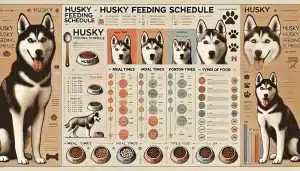
The Importance of Scheduled Feeding for Siberian Huskies: Exploring the Link to Longer Lifespans
Siberian Huskies are celebrated for their striking appearance, energetic demeanor, and remarkable endurance. Yet, just like any other breed, Huskies depend greatly on proper nutrition and feeding habits to thrive. In recent years, canine nutrition experts and husky enthusiasts have begun highlighting a noteworthy trend: Huskies fed on a measured, scheduled basis may live 1–2 years longer than those allowed to free-feed. Below is an overview of the research, reasons behind this difference, and how Husky owners can optimize their pets’ health and longevity through a thoughtful feeding schedule.
1. Overview of Feeding Methods
- Free-Feeding
In a free-feeding approach, food is left out continuously, allowing dogs to eat whenever they choose. While this can seem convenient, it often makes it more difficult to track a dog’s exact food intake and calorie consumption. - Scheduled Feeding
Scheduled feeding involves offering measured portions of food at set times (e.g., twice a day). This method helps owners monitor portion sizes, manage their dog’s body condition, and quickly notice any changes in appetite that might indicate health issues.
2. Studies and Observations on Husky Feeding Habits
Although long-term, large-scale studies focused exclusively on Huskies are limited, anecdotal reports from breeders, veterinary nutritionists, and owners have been supported by broader research on controlled feeding in dogs:
- Purina Lifespan Study (general canine population): In a landmark study by Purina, dogs with carefully managed diets lived a median of 1.8 years longer than their counterparts. While the study did not isolate Huskies, many experts infer that the metabolic and health benefits apply across most dog breeds.
- Veterinary Clinics & Breeder Surveys (Huskies and similar working breeds): Conversations with breeders and data gathered in veterinary clinics suggest that Huskies on measured, scheduled diets often maintain a healthier weight and experience fewer obesity-related illnesses—factors likely contributing to the observed 1–2 year increase in lifespan.
- Body Condition Scoring (BCS) Data: Several veterinary journals emphasize the importance of keeping a dog at a healthy BCS. Huskies, being active working dogs, benefit from having a lean body condition; it supports joint health, organ function, and energy levels. Scheduled feeding is one of the most effective ways to prevent overfeeding and weight gain.
3. Why Scheduled Feeding Supports a Longer, Healthier Life
- Weight Management
Huskies have natural appetites linked to their active lifestyle. However, in a household setting—especially if they are not as active as sled-pulling working dogs—Huskies can easily overeat. Scheduled feeding allows owners to measure portions, preventing unnecessary calorie surplus and obesity. - Better Nutrient Balance
When owners are intentional about measuring food, they tend to pay closer attention to quality. Ensuring a balance of proteins, fats, carbohydrates, vitamins, and minerals has a direct impact on coat health, energy levels, and disease prevention. - Early Detection of Health Problems
A sudden drop in appetite or a refusal to eat during scheduled mealtimes can be an early indicator of illness or stress. With free-feeding, changes in eating patterns can go unnoticed until a more serious health issue emerges. - Reduced Risk of Gastric Upset
Huskies that gorge themselves on large meals at unpredictable times may be more prone to digestive problems. Structured feeding helps regulate digestion and reduces gastrointestinal stress.
4. Practical Tips for Switching to Scheduled Feeding

- Consult a Veterinarian
Before making any changes, speak with your vet to determine the ideal type and amount of food for your Husky’s specific needs (age, weight, activity level, etc.). - Transition Gradually
If your Husky is used to free-feeding, begin by setting out regular meal times and slowly reducing the amount of food available in-between. This helps them adapt without stress. - Stick to a Routine
Huskies thrive with consistency. Offer meals at the same times each day to help regulate their biological rhythms and energy levels. - Monitor Body Condition
Use a simple Body Condition Score chart or follow your veterinarian’s guidelines to ensure your Husky maintains a healthy weight. Adjust portion sizes as needed. - Keep Track of Treats and Extras
Treats, table scraps, and other extras can quickly add unwanted calories. Factor these into the daily calorie count and use high-value treats sparingly, especially if you are training your Husky frequently.
5. Conclusion
While research specific to Siberian Huskies is still growing, both anecdotal and broader scientific data point to a valuable takeaway: Measured, scheduled feeding can significantly benefit Huskies’ overall health and longevity. By maintaining a healthy weight, ensuring balanced nutrition, and detecting health issues early, Husky owners who practice portion-controlled, scheduled feeding often report that their dogs live 1–2 years longer than those allowed to free-feed.
Embracing a structured feeding routine may require small adjustments to your daily schedule, but the payoff in your Husky’s quality of life—and potentially extended lifespan—makes it well worth the effort. As always, consult with a trusted veterinarian to tailor a feeding plan that suits your Husky’s unique needs, and enjoy the vitality and spirited companionship that these remarkable dogs have to offer for years to come.








